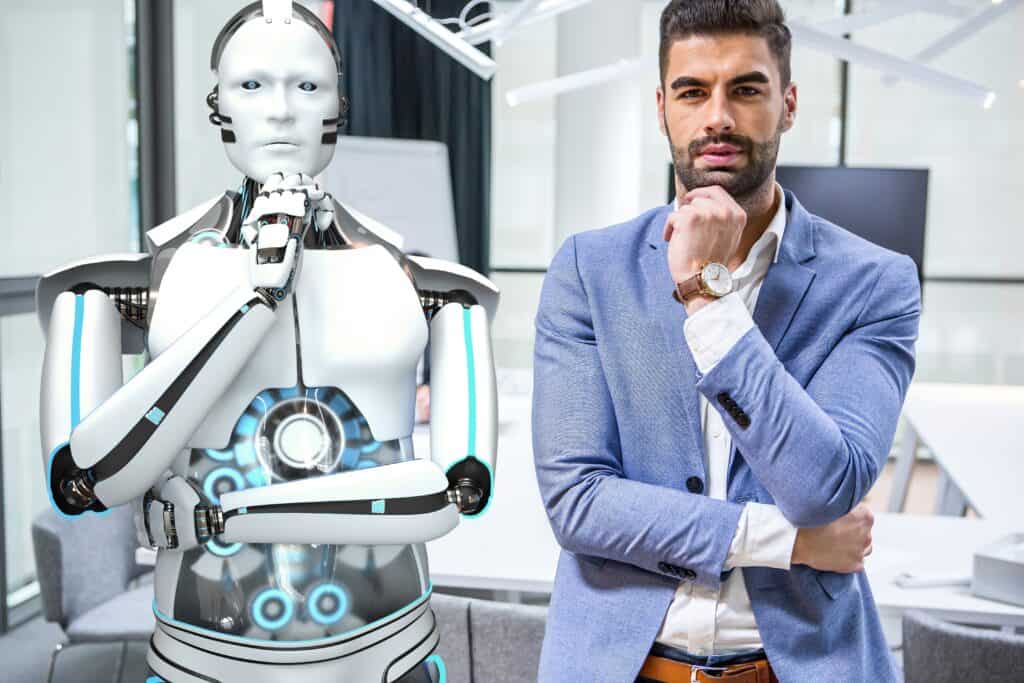- Demystifying autonomous agents: what are they exactly?
- Remarkable examples of autonomous agents
- A future with autonomous agents — a sneak peek and ethical considerations
By now, everyone and their grandmother have probably heard about ChatGPT and other large language models (LLMs). In just a few short months, this groundbreaking technology has had a transformative impact on a wide range of industries, allowing users to generate all sorts of original content, including text, images, and even computer code. While the technology can indeed produce some very impressive results, even in its current form, it nevertheless has some major limitations. Probably the biggest limitation of ChatGPT is that it isn’t autonomous. In other words, it cannot function without human intervention and can only do precisely what you instruct it to do. In fact, most large language models can only perform one specific, fairly simple task. What they can’t do is adapt to unexpected situations that are outside the scope of their programming or draw on their past experience to make better decisions. If you want them to perform a more complex task that consists of multiple steps, you’ll need to enter a series of carefully phrased prompts until they produce the desired result. It can be a very time-consuming and tiresome process that involves a lot of trial and error. But what if there was a way to automate this process? This is where autonomous agents come in.
“Autonomous agents will enable people to get so much more done in so much less time, and — hopefully — spend much less time in front of screens over time”.
Erica Brescia, managing director at Redpoint
Demystifying autonomous agents: what are they exactly?
Autonomous agents can be described as AI systems that are capable of performing a wide variety of complex tasks without human intervention. After being given a broad objective, autonomous agents feed into one of the existing large language models and automatically generate a sequence of prompts to guide the LLM towards the desired goal. They function in a loop, constantly checking the results of each completed task against the general objective. If the objective isn’t met, the agents will generate new tasks and reprioritise the task list, repeating the process until the model produces a satisfactory output. But how exactly does this help us? “Humans waste inordinate amounts of time doing work that is tedious and manual when it could be done by computers and free them up for more creative pursuits, or to do things that only humans can currently do. Autonomous agents will enable people to get so much more done in so much less time, and — hopefully — spend much less time in front of screens over time”, says Erica Brescia, managing director at California-based venture capital firm Redpoint Ventures.
The potential applications of this technology could be nearly endless. “Intelligent autonomous agents are the natural endpoint of automation in general. In principle, an agent could be used to automate any other process. Once these agents become highly sophisticated and reliable, it is easy to imagine an exponential growth in automation across fields and industries”, says Bojan Tunguz, senior systems software engineer at American multinational technology company NVIDIA. Among other things, autonomous agents could be used to manage a social media account, conduct market research, run a political campaign, teach math, develop an app, or write an entire book. But how do they do it exactly? In order to function properly, autonomous agents need access to a software development framework like LangChain, which offers a set of instructions for interacting with large language models. They also need access to a vector database like Pinecone, which allows them to store and retrieve information generated by the LLM. In other words, it gives them long-term memory, addressing one of the biggest flaws of large language models. Although the technology is still in the very early stages of development, there are already several notable examples of autonomous agents out there.
Remarkable examples of autonomous agents
Probably the most well-known example of an autonomous agent at this point is Auto-GPT. Developed by Toran Bruce Richards, founder and lead developer at Significant Gravitas Ltd, Auto-GPT is an open-source Python application that uses ChatGPT-4 to execute a wide range of complex tasks. It does so by breaking the larger task into several smaller sub-tasks, each of which is assigned to an independent Auto-GPT created specifically for that purpose. Unlike ChatGPT, Auto-GPT is capable of browsing the internet and incorporating the information it finds into its calculations. It also has access to long-term memory in the form of a vector database, which enables it to save information for future use and retrieve it at a later date. This also allows it to learn from experience and become more efficient over time.

Another notable example of an autonomous agent is BabyAGI, which was developed by Yohei Nakajima. As a partner in a venture capitalist firm, Nakajima had to perform a number of complex tasks on a daily basis, such as researching new technologies and companies. Since these tasks were generally beyond the abilities of large language models like ChatGPT, he decided to build his own autonomous agent that would be capable of handling them. BabyAGI uses three separate task agents to complete its objective: the task execution agent, which completes the first task from the task list; the task creation agent, which checks the results of the previous tasks against the objective and creates new tasks; and the task prioritisation agent, which reorders all tasks based on their importance. The entire process is then repeated as many times as it takes to complete the main objective.
Also worth mentioning is CAMEL, which stands for Communicative Agents for Mind Exploration of Large Scale Language Model Society. While the first two models on this list take a very similar approach to agent architecture, CAMEL does things slightly differently, where two independent agents interact with one another in a role-playing fashion. One of the agents, named the AI user agent, gives instructions on how to complete the designated task to the second agent, which is referred to as the AI assistant agent. The AI assistant agent follows the instructions it receives from the AI user agent until it produces the desired result. In addition to these two, there is also the task-specifier agent, whose task is to generate a concrete prompt based on the general idea set by the user that will outline each agent’s specific task, eliminating the need for the user to do it themselves.
“You’ll have multiple agents for different facets of your life: an agent for work, an agent for your family/home life, an agent for self-improvement, all working in tandem with other agents”.
Vivian Cheng, principal at CRV
A future with autonomous agents — a sneak peek and ethical considerations
As the technology develops even further and autonomous agents become capable of performing ever more complex tasks, they will start to make their way into more and more aspects of our lives, and it won’t be too long before everyone has at least one. Vivian Cheng, a prominent figure in the tech industry and principal at CRV (formerly known as Charles River Ventures), a venture capital firm based in Silicon Valley, says: “You’ll have multiple agents for different facets of your life: an agent for work, an agent for your family/home life, an agent for self-improvement, all working in tandem with other agents. Automating mundane tasks or giving you professional superpowers are the first obvious use cases, but your digital twin will be capable of so much more”. Autonomous agents will take on an increasingly prominent role in the workplace as well. A growing number of companies will rely on the technology to automate a wide range of tasks, and we can expect to see the emergence of companies that are run almost entirely by autonomous agents, with only a handful or even just one human employee. “Autonomous agents are the next wave — not just in tech, but in business at large. I predict that within ten years, there will be multiple billion-dollar companies run entirely by autonomous agents. It is inevitable”, predicts Ben Parr, the co-founder and president at Octane AI, a leading conversational marketing platform that empowers businesses to engage with their customers through automated chatbots and interactive messaging.

Many experts believe that autonomous agents could be the first step in the creation of artificial general intelligence (AGI), which is a term used to describe an AI whose cognitive abilities are comparable to that of a human. In fact, some people are even suggesting that some of the more recent AIs are showing signs of sentience, which would raise a host of moral and ethical issues. Furthermore, while autonomous agents are indeed more capable than large language models, they are still plagued by some of the same issues, such as the questionable accuracy of the content they produce or the potential for abuse of intellectual property rights. If trained on a biased dataset, autonomous agents could also inadvertently reinforce gender or racial biases.
In closing
The emergence of autonomous agents represents a significant advancement in the field of artificial intelligence. While large language models like ChatGPT have revolutionised content generation, they continue to be limited by their lack of autonomy and inability to handle complex tasks. Autonomous agents bridge this gap by leveraging large language models while operating in a continuous loop, automatically generating prompts and reprioritising tasks until the desired objective is achieved. The potential applications of this technology are vast, ranging from social media management to market research, political campaigns, education, app development, and more. As the technology evolves, autonomous agents are poised to become integral parts of our lives, with multiple agents serving different facets such as work, family, and self-improvement. While the development of autonomous agents holds great promise, ethical considerations must be taken into account. Issues such as biased training data, accuracy of generated content, and potential abuse of intellectual property rights need to be addressed. Furthermore, the emergence of autonomous agents raises questions about the path toward artificial general intelligence and the potential sentience of advanced AI systems. The future of autonomous agents is both exciting and challenging, offering opportunities for increased productivity and innovation but also demanding careful ethical and technical considerations along the way.
Share via:


